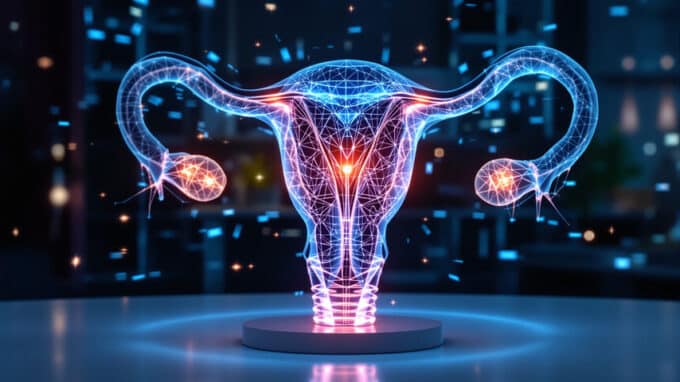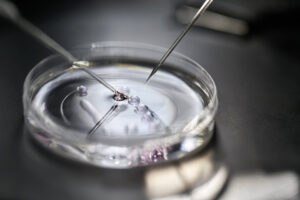Artificial intelligence plays a central but very diverse role in many areas of life today. It is changing work processes, communication, medicine, and the economy. It is also expanding many areas of medical diagnostics, therapy, research, and life planning related to fertility.
AI in the Field of Reproduction
AI is playing an increasingly important role in modern reproductive medicine by helping to identify fertility problems earlier and make treatments more precise. In diagnostics, AI can analyze large amounts of data from hormone levels, ultrasound images, or cycle data, thereby identifying patterns that would be difficult for doctors to see on their own. This makes it possible to identify indications of low egg reserve, irregular ovulation, or sperm quality problems more quickly. AI is also being used more and more successfully in in vitro fertilization (IVF).

AI also helps to tailor treatments more individually, for example by making predictions about how patients might respond to certain hormone stimulations. AI also enables a more objective assessment of sperm motility and shape in sperm analysis. In addition, AI improves the interpretation of genetic data, which plays an important role in hereditary fertility disorders or preimplantation diagnostics.
In addition to clinical medicine, AI also influences life planning: cycle apps and wearables use AI models to predict ovulation and fertile days more accurately. However, the influence on actual physical fertility is minimal—AI does not change human biology, but rather the diagnostic and treatment options available, as well as the decisions people make about their fertility.
The Benefits for Women and Men
Artificial intelligence influences fertility in many ways, but without directly changing biological fertility. In women, AI primarily helps in diagnostics by analyzing hormone levels, ultrasound images of the egg reserve, or patterns in the menstrual cycle, thereby enabling early detection of disorders such as irregular ovulation, hormonal imbalances, or premature decline in ovarian function. AI-supported models also assist in planning hormonal stimulation for IVF treatments by predicting how the ovaries might respond to specific treatments on an individual basis. This increases the chance of a good egg yield while reducing the risk of overstimulation.
For men, AI is playing an increasingly important role in the analysis of sperm quality. Through automated image evaluation, it can assess sperm motility, shape, and concentration more accurately and objectively than the human eye. Some laboratories are already using AI algorithms to select particularly viable-looking sperm for ICSI treatment, which increases the chances of successful fertilization. In IVF clinics, AI is fundamentally changing treatment procedures. Modern incubators generate time-lapse video recordings of embryos from the first cell stage to the blastocyst stage.

Cycle apps and wearables also benefit greatly from AI. By analyzing temperature data, heart rate, sleep patterns, hormone fluctuations from saliva tests, or movement profiles, they can predict ovulation much more accurately than simple calendar or temperature methods. AI helps to identify individual patterns that would otherwise be easily overlooked—such as shortened follicular phases, silent ovulations, or stress-related cycle disorders. This allows women to determine their fertile days more precisely, which both facilitates fertility treatments and enables better cycle health. Overall, AI does not change biological fertility, but it significantly improves diagnostics, treatment decisions, and chances of success in reproductive medicine, and provides people with better tools to understand their bodies and fertility.
AI and Fertility Treatments
Artificial intelligence plays an increasingly important but supportive role in IVF medicine today, changing many steps of the treatment without replacing medical expertise. A key area of application is the assessment of embryos: modern time-lapse incubators produce continuous image series of embryo development, which AI analyzes to identify growth rhythms, division patterns, and subtle morphological features. This improves the selection of those embryos that have the highest chances of successful implantation. AI is also used to better plan stimulation protocols by evaluating large amounts of data from previous cycles and predicting how strongly a patient’s ovaries might respond to certain hormone doses. This makes it easier to avoid over- or under-stimulation.
AI also supports everyday laboratory work in sperm analysis by objectively and reproducibly assessing the motility, shape, and vitality of sperm and, in some procedures, identifying those sperm that appear most promising for ICSI treatment. In addition, AI helps to identify risks, for example by revealing patterns that indicate a low probability of implantation or an increased termination rate of an IVF cycle. In some clinics, AI is also used to organize processes, perform quality control, and evaluate genetic data, for example in preimplantation diagnostics.
Overall, AI leads to more precise decisions, better embryo selection, and more individualized treatment strategies in IVF. However, it does not automatically increase the success rate of every treatment, but serves as an additional tool that complements human experience rather than replacing it.
The Disadvantages of AI
Although artificial intelligence enables enormous advances in fertility medicine, it also comes with significant risks and limitations. A key problem is that AI models are only as good as the data they have been trained on. If these data sets are not sufficiently diverse—for example, because they originate predominantly from certain age groups, ethnic groups, or specific clinical centers—the models may be biased and perform less well for some patients. There is also a risk that AI will convey predictions with a degree of accuracy that appears higher than it actually is: many models provide probabilities, but these can easily be misinterpreted as definitive statements in everyday clinical practice. This can lead to inflated expectations or medical decisions that rely too heavily on algorithmic recommendations.
Another critical issue is the lack of transparency. Many AI systems work like “black boxes,” whose internal decision-making processes are difficult to understand, even for experts. In reproductive medicine, where decisions with great emotional and financial significance are made, this can undermine trust or make it difficult to provide information. Data protection issues also play a role, as AI-supported systems process highly sensitive health data, cycle information, or genetic profiles. If these are not carefully protected, there are risks to privacy and potential for misuse.
There is also the possibility that practitioners will rely too heavily on AI, which could diminish the importance of human experience and clinical judgment. AI serves as a support, not a substitute for medical expertise, but this line can easily become blurred in the hectic everyday clinical routine. Finally, it is clear that AI, despite its capabilities, is not perfect: it can misjudge embryos, overlook unusual disease patterns, or provide an incorrect assessment of sperm quality in men when disruptive factors occur. In some areas, AI is more of a statistical tool than a deep biological understanding; it recognizes patterns without explaining why they occur and therefore has natural limitations, especially in complex biological processes such as fertility.
In summary, AI offers enormous opportunities, but it requires careful handling, clear transparency, good data quality, and a responsible combination of technical support and human expertise.





